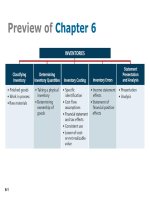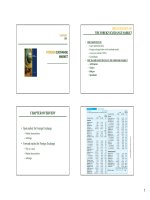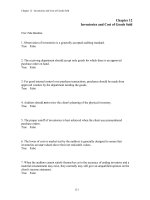Lecture Principles of financial accouting - Chapter 6: Inventories and cost of sales
Bạn đang xem bản rút gọn của tài liệu. Xem và tải ngay bản đầy đủ của tài liệu tại đây (1.15 MB, 40 trang )
Chapter 6
INVENTORIES AND
COST OF SALES
PowerPoint Authors:
Susan Coomer Galbreath, Ph.D., CPA
Charles W. Caldwell, D.B.A., CMA
Jon A. Booker, Ph.D., CPA, CIA
Cynthia J. Rooney, Ph.D., CPA
Winston Kwok, Ph.D., CPA
McGrawHill/Irwin
Copyright © 2011 by The McGrawHill Companies, Inc. All rights reserved.
6 2
C1
DETERMINING INVENTORY ITEMS
Merchandise inventory includes all goods that a
company owns and holds for sale, regardless of
where the goods are located when inventory is
counted.
Items
Items requiring
requiring special
special attention
attention include:
include:
Goods in
Transit
Goods on
Consignment
Goods
Damaged or
Obsolete
6 3
C1
GOODS IN TRANSIT
FOB Shipping Point
Public
Carrier
Seller
Buyer
Ownership passes
to the buyer here.
Public
Carrier
Seller
FOB Destination Point
Buyer
6 4
C1
GOODS ON CONSIGNMENT
Merchandise is included in the inventory of the
consignor, the owner of the inventory.
Consignee
Thanks for selling my
inventory in your
store.
Consignor
6 5
C1
GOODS DAMAGED OR OBSOLETE
Damaged or obsolete goods are not counted in
inventory if they cannot be sold.
Cost should be reduced to net realizable
value if they can be sold.
Net realizable value is the estimated
selling price in the ordinary course of
business less the estimated costs of
completion and the estimated costs
necessary to make the sale.
6 6
C2
DETERMINING INVENTORY COSTS
Include all expenditures necessary to bring an item to
a salable condition and location.
Minus
Minus
Discounts
Discounts
and
and
Allowances
Allowances
Plus
Plus Import
Import
Duties
Duties
Invoice
Cost
Plus
Plus
Freight
Freight
Plus
Plus
Insurance
Insurance
Plus
Plus
Storage
Storage
6 7
C2
INTERNAL CONTROLS AND TAKING A
PHYSICAL COUNT
Most companies take a
physical count of
inventory at least once
each year.
When the physical count
does not match the
Merchandise Inventory
account, an adjustment
must be made.
Good internal controls over count include:
1.Pre-numbered inventory tickets.
2.Counters have no inventory responsibility.
3.Counts confirm existence, amount, and
quality of inventory item.
4.Second count is taken.
5.Manager confirms all items counted.
6 8
C2
INVENTORY COSTING UNDER
A PERPETUAL SYSTEM
Inventory
affects . . .
Balance
Sheet
Income
Statement
The matching
principle requires
matching costs
with sales.
6 9
C2
INVENTORY COST FLOW
ASSUMPTIONS
Management decisions in accounting for inventory
involve the following:
1.Items included in inventory and their costs.
2.Costing method (specific identification, FIFO, LIFO,
or weighted average).
3.Inventory system (perpetual or periodic).
4.Use of market values or other estimates.
6 10
P1
INVENTORY COST FLOW
ASSUMPTIONS
First-In, First-Out
(FIFO)
Assumes costs flow in the order
incurred.
Last-In, First-Out
(LIFO)
Assumes costs flow in the
reverse order incurred.
Weighted
Average
Assumes costs flow at an
average of the costs available.
6 11
P1
INVENTORY COSTING ILLUSTRATION
Here is information about the mountain bike inventory of
Trekking for the month of August.
6 12
P1
SPECIFIC IDENTIFICATION
6 13
P1
SPECIFIC IDENTIFICATION
Income
Income Statement
Statement
Cost
Cost of
of Goods
Goods Sold
Sold
Balance
Balance Sheet
Sheet Inventory
Inventory
6 14
P1
SPECIFIC IDENTIFICATION
Here are the entries to record the purchases and sales. The
numbers in red are determined by the cost flow assumption used.
All purchases and sales are made on credit.
The selling price of inventory was as follows:
8/14 $130
8/31 150
6 15
P1
FIRST-IN, FIRST-OUT (FIFO)
Oldest
Costs
Cost of
Goods Sold
Recent
Costs
Ending
Inventory
6 16
P1
FIRST-IN, FIRST-OUT (FIFO)
6 17
P1
FIRST-IN, FIRST-OUT (FIFO)
6 18
P1
FIRST-IN, FIRST-OUT (FIFO)
Here are the entries to record the purchases and sales entries. The
numbers in red are determined by the cost flow assumption used.
All purchases and sales are made on credit.
The selling price of inventory was as follows:
8/14 $130
8/31 150
6 19
P1
LAST-IN, FIRST-OUT (LIFO)
Recent
Costs
Oldest
Costs
Cost of
Goods Sold
6 20
P1
LAST-IN, FIRST-OUT (LIFO)
6 21
P1
LAST-IN, FIRST-OUT (LIFO)
6 22
P1
LAST-IN, FIRST-OUT (LIFO)
Here are the entries to record the purchases and sales entries.
The numbers in red are determined by the cost flow assumption
used.
All purchases and sales are made on credit.
The selling price of inventory was as follows:
8/14 $130
8/31 150
6 23
P1
WEIGHTED AVERAGE
When a unit is sold, the
average cost of each unit in
inventory is assigned to cost of
goods
Cost ofsold.
Goods Units on hand
Available for
Sale
÷
on the date of
sale
6 24
P1
WEIGHTED AVERAGE
6 25
P1
WEIGHTED AVERAGE









